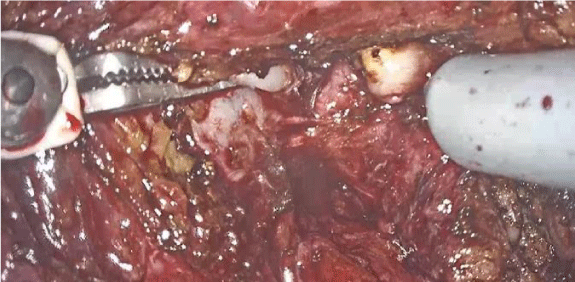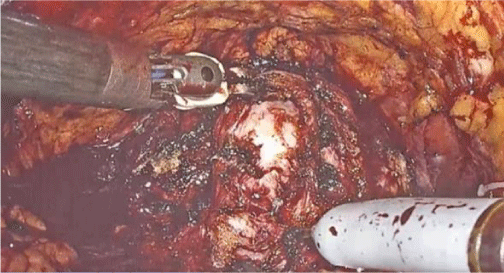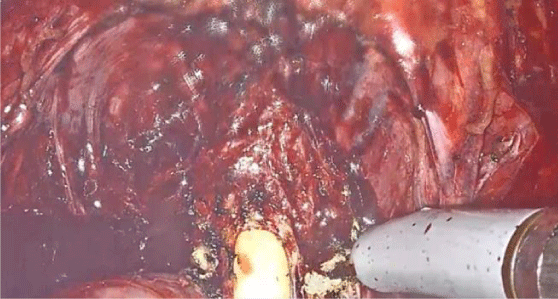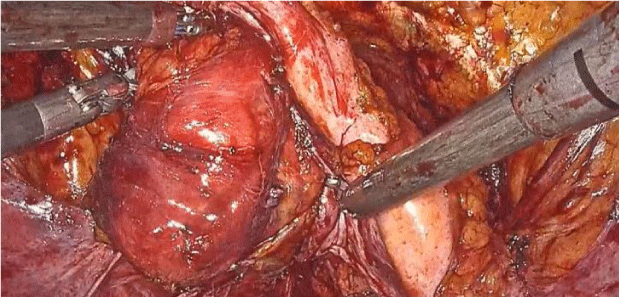Archive of Urological Research
Robotic assisted laparoscopic radical prostatectomy with the new surgical robot HugoTM RAS in a man with proctocolectomy and restorative ileal pouch-anal anastomosis. The first European urological step-by-step procedure
Totaro A, Scarciglia E*, Ragonese M, Cretì A, Bizzarri FP, Campetella M, Gandi C, Palermo G, Racioppi M and Sacco E
Cite this as
Totaro A, Scarciglia E, Ragonese M, Cretì A, Bizzarri FP, et al. (2023) Robotic assisted laparoscopic radical prostatectomy with the new surgical robot HugoTM RAS in a man with proctocolectomy and restorative ileal pouch-anal anastomosis. The first European urological step-by-step procedure. Arch Urol Res 7(1): 004-007. DOI: 10.17352/aur.000043Copyright
© 2023 Totaro A, et al. This is an open-access article distributed under the terms of the Creative Commons Attribution License, which permits unrestricted use, distribution, and reproduction in any medium, provided the original author and source are credited.Robotic-Assisted Laparoscopic Radical Prostatectomy (RARP) is the gold standard surgical treatment for localized clinically significant prostate cancer. In patients undergone previous abdominal or pelvic surgery, it can be difficult to perform and it is also contraindicated execution of radiotherapy.
We have described step-by-step the first case of RARP performed with the robotic system HugoTM RAS in a patient previously subjected to proctocolectomy and ileal pouch-anal anastomosis packaging for ulcerative colitis. The procedure was found to be safe and feasible, with intra- and post-operative data overlapping those of the same procedure in the general population. Execution by an experienced surgeon is in any case recommended.
Introduction
HugoTM RAS is a new robotic technology for minimally invasive abdominal surgical treatment. Its feasibility, the setting and the outcomes of Robotic Assisted Laparoscopic Radical Prostatectomy (RARP) are recently reported [1,2].
Restorative proctocolectomy with ileal pouch-anal anastomosis (RP-IPAA) is the gold standard surgical treatment for ulcerative colitis and familial adenomatous polyposis [3-6].
The treatment of localized prostate cancer (PCa) in men with a prior history of RP-IPAA remains to be definitively assessed and represents a surgical challenge. Radiation therapy is typically avoided in these patients, due to concerns regarding an injury to the pouch. To date, only two cases of RARP and a few cases of open radical prostatectomy (RP) were reported in the literature [7,8].
We present our surgical technique, outcomes and feasibility assessment following robotic-assisted laparoscopic prostatectomy with the new surgical robot HugoTM RAS.
Case report
The patient was a 68 years-old man with a diagnosis of prostate cancer (Gleason Score 7 = 4+3 in the left lobe) on a biopsy performed after an incidental finding of a total PSA serum level of 9 ng/ml and a suspicious PIRADS 3 area of 12 mm in the transitional zone at multiparametric RMN. He had a history of restorative proctocolectomy (3 years before) for ulcerative colitis after decennials of pharmacological therapies. A complete oncological staging was performed with total body scintigraphy and thorax plus abdomen CT, both negative for metastasis. Prostate volume was about 59 ml and digital rectal examination found an enlarged prostate without the presence of nodules or increased consistency. He also has a cardiological history of biological valvular implantation, and he has a body mass index of 26.85 kg/mq.
The pre-operative risk of lymph node involvement was less than 7% (using the 2018 version of the Briganti nomogram), and with negativity at radiological oncological staging, we preferred to omit lymph node dissection.
Procedural technique [1,2]
Step 1 – Abdominal access and adhesions’ lysis
The RARP was performed with a transperitoneal approach following careful and extensive lysis of multiple adhesions, that required peri-umbilical laparotomy of 6 cm long (over the previous laparotomy), to place optical trocar and additional assistant port under direct visualization. This additional assistant port was used for extensive laparoscopic lysis of adhesions in the abdominal cavity and pelvis, to provide sufficient space to place all the robotics’ and assistant ports and instruments.
Step 2 – Docking
A typical docking setting was performed once all the trocars were placed, with orientation and positioning already described, with the patient in a Trendelenburg position of 30° and the endoscope arm between the legs.
Robotic instruments
The procedure was performed according to our conventional four-robotic-instruments setup: monopolar curved scissors, 3D-endoscope, bipolar Maryland grasper and Cadiere forceps.
Step 3 – The RARP
Montsouris’s technique was chosen, with the following validated steps [1,9]:
- Seminal vesicle isolation and dissection with extensive lysis of adhesions with the ileus and distal segment of the pouch [Figure 1].
- Dissection of posterior space between the prostate and the pouch [Figure 2].
- Bladder anterior detachment and endopelvic fascia incision.
- Bladder neck dissection of a third lobe voluminous prostate with bladder neck sparing technique [Figure 3].
- Lateral dissection of the prostate. The nerve-sparing approach was not performed because the patient was affected by iatrogenic erectile dysfunction due to the previous pelvic surgery.
- Apical dissection preserving puboprostatic ligament complex, arcus tendinous and endopelvic fascia [Figure 4].
- Vesicoureteral anastomosis.
- After filling the pelvis with saline solution, the integrity of the ileal pouch was confirmed with gentle insufflation of air under vision. No pouch injury was found [Figure 5].
Intra-operative data
The estimated blood loss was 200 ml and the VAS scale of pain in the recovery room was 1. The effective surgery time was 221 minutes, 42 minutes above our average time of 179 minutes and the console surgical time was of 103 minutes, against our average time of 101 minutes. No intra or peri-operative complications were reported, and no technical and robotic problems were reported, too.
Post-operative patient outcome
Discharge was on the 4th postoperative day, as our internal standard, without any early complication to report. Abdominal drainage was removed before the discharge, after an average tribute of 50 ml of serosanguineous quality per day. Histopathological specimen found an acinar prostatic adenocarcinoma, Gleason Score 3+4 = 7, pT2c R0. The vesical catheter was removed on the 14th postoperative day, after the performance of retrograde and voiding urethrocystography, negative for anastomotic leakage. At 30 days after surgery, no stress incontinence was referred by the patient.
Discussion
Ulcerative colitis is an inflammatory colon and rectum disease affecting millions of adults and children worldwide. Despite the progress of medical therapy, which has broadened the possible treatments after the failure of corticosteroids, surgery is still required in 15% - 35% of patients affected by ulcerative colitis [3,4]. Restorative proctocolectomy with ileal pouch-anal anastomosis (RP-IPAA) remains the gold standard surgical procedure in men affected by chronic ulcerative colitis and familial adenomatous polyposis. This procedure improves the quality of life (QoL), allowing to avoid the permanent intestinal stoma, maintaining gastrointestinal continuity, and preserving the anal sphincter. Unsurprisingly, there is an increasing number of patients who are affected by both PCa and inflammatory bowel disease (IBD) [10].
Diagnosis and management of PCa can be challenging due to the altered pelvic anatomy from the previous surgery. Patients with RP-IPAA are poor candidates for radical prostatectomy due to loss of anatomic tissue and planes.
It's well known that the risk of pouch failure may be increased after the diagnosis of PCa with or without treatment, requiring permanent diversion, pouchectomy, or a redo pouch [6,11]. However, for those with retained pouches, their pouch function and QoL did not seem to be adversely affected [12]. Open radical retropubic prostatectomy (RRP) in patients with PC-IPAA is the preferred surgical approach, offering good oncologic results without significant modification of QoL [7].
Conversely, external beam radiotherapy is associated with a high risk of pouch failure and should be avoided. However, brachytherapy may be feasible, but negative side effects should not be overlooked [13].
To date, only two cases of RARP were reported by Leapman, et al, in patients with RP-IPAA (J-pouch) [8]. In this study, the authors described RARP as a feasible and oncologically efficacious procedure, even if technically challenging yet.
To our knowledge, this is the first case of successful robotic-assisted laparoscopic prostatectomy with the new surgical robot HugoTM RAS in patients affected by clinically significant prostate cancer with RP-IPAA and the third case of RARP reported in the literature. The operation was performed by an experienced robotic surgeon (A.T.), confident with the surgical robot HugoTM RAS, with the collaboration of a skilled general surgeon (L.S.) who previously performed the RP-IPAA himself.
The topic and most difficult steps of the operation were the following:
- access to the abdominal space: multiple adhesions were encountered that required careful and extensive lysis of adhesions to place the optical trocar under vision and access to the pelvic space.
- seminal vesicle dissection: multiple adhesions with the distal section of the pouch and scarring from previous surgery were found, due to the modified pelvic anatomy and the loss of the pouch of Douglas.
- dissection of the posterior space between the prostate and the pouch: the dissection was particularly complex due to the presence of scarring and the loss of the Denonvilliers fascia from previous surgery.
For the retrograde approach, we have chosen Montsouris’s technique to have direct safety control of the pouch during the development of the posterior prostatic plane from the base to the apex.
Our first successful experience suggests that RARP may be offered to men with clinically significant prostate cancer and RP-IPAA [14]. It’s important to remark that this operation remains a challenging procedure with several difficult steps. For this reason, considerable surgeon experience is recommended. Given the complexity of the case, we believe that both a skilled robotic surgeon and a skilled general surgeon are necessary to complete this case successfully.
Conclusion
RARP in patients who s previously undergone restorative proctocolectomy with ileal pouch-anal anastomosis (RP-IPAA) is feasible and, oncologically efficacious, but technically challenging Montsouris’s technique could be the best approach to dissect the posterior prostatic space to have a direct and safety control of the pouch itself. This represents the first report of successful RARP with the new surgical robot HugoTM RAS in these patients and the third case of robotic radical prostatectomy reported in the literature. RARP may be offered by experienced robotic surgeons for patients with inflammatory bowel disease or familial adenomatous polyposis with RP-IPAA.
- Totaro A, Campetella M, Bientinesi R, Gandi C, Palermo G, Russo A, Aceto P, Bassi P, Sacco E. The new surgical robotic platform HUGOTM RAS: System description and docking settings for robot-assisted radical prostatectomy. Urologia. 2022 Nov;89(4):603-609. doi: 10.1177/03915603221107855. Epub 2022 Jun 28. PMID: 35765756.
- Sarchi L, Mottaran A, Bravi CA, Paciotti M, Farinha R, Piazza P, Puliatti S, De Groote R, De Naeyer G, Gallagher A, Breda A, Mottrie A. Robot-assisted radical prostatectomy feasibility and setting with the Hugo™ robot-assisted surgery system. BJU Int. 2022 Nov;130(5):671-675. doi: 10.1111/bju.15819. Epub 2022 Jun 26. PMID: 35689414.
- Feuerstein JD, Cheifetz AS. Ulcerative colitis: epidemiology, diagnosis, and management. Mayo Clin Proc. 2014 Nov;89(11):1553-63. doi: 10.1016/j.mayocp.2014.07.002. Epub 2014 Sep 8. PMID: 25199861.
- Biondi A, Zoccali M, Costa S, Troci A, Contessini-Avesani E, Fichera A. Surgical treatment of ulcerative colitis in the biologic therapy era. World J Gastroenterol. 2012 Apr 28;18(16):1861-70. doi: 10.3748/wjg.v18.i16.1861. PMID: 22563165; PMCID: PMC3337560.
- Heikens JT, de Vries J, van Laarhoven CJ. Quality of life, health-related quality of life and health status in patients having restorative proctocolectomy with ileal pouch-anal anastomosis for ulcerative colitis: a systematic review. Colorectal Dis. 2012 May;14(5):536-44. doi: 10.1111/j.1463-1318.2010.02538.x. PMID: 21176062.
- Diederen K, Sahami SS, Tabbers MM, Benninga MA, Kindermann A, Tanis PJ, Oomen MW, de Jong JR, Bemelman WA. Outcome after restorative proctocolectomy and ileal pouch-anal anastomosis in children and adults. Br J Surg. 2017 Nov;104(12):1640-1647. doi: 10.1002/bjs.10678. Epub 2017 Sep 20. PMID: 28940230.
- Umbreit EC, Dozois EJ, Crispen PL, Tollefson MK, Karnes RJ, Blute ML. Radical prostatectomy for prostate cancer after ileal pouch-anal anastomosis offers oncologic control and sustains quality of life. J Am Coll Surg. 2010 Feb;210(2):232-9. doi: 10.1016/j.jamcollsurg.2009.09.041. Epub 2009 Dec 3. PMID: 20113945.
- Leapman M, Kwon YS, Collingwood SA, Chin E, Katsigeorgis M, Hobbs AR, Samadi DB. Robotic assisted laparoscopic prostatectomy in men with proctocolectomy and restorative ileal pouch-anal anastomosis. Case Rep Urol. 2014;2014:538382. doi: 10.1155/2014/538382. Epub 2014 Feb 5. PMID: 24653856; PMCID: PMC3933405.
- Guillonneau B, Vallancien G. Laparoscopic radical prostatectomy: the Montsouris technique. J Urol. 2000 Jun;163(6):1643-9. doi: 10.1016/s0022-5347(05)67512-x. PMID: 10799152.
- Haddad A, Al-Sabbagh MQ, Al-Ani H, Siyam AM, Aborajooh E, Iwata T, Kimura S, Shariat SF, Abufaraj M. Inflammatory bowel disease and prostate cancer risk: A systematic review. Arab J Urol. 2020 May 19;18(4):207-212. doi: 10.1080/2090598X.2020.1761674. PMID: 33312730; PMCID: PMC7717159.
- Alsafi Z, Snell A, Segal JP. Prevalence of 'pouch failure' of the ileoanal pouch in ulcerative colitis: a systematic review and meta-analysis. Int J Colorectal Dis. 2022 Feb;37(2):357-364. doi: 10.1007/s00384-021-04067-6. Epub 2021 Nov 26. PMID: 34825957; PMCID: PMC8803821.
- Lian L, Ashburn J, Remer EM, Remzi FH, Monga M, Shen B. Impact of Prostate Cancer and Its Treatment on the Outcomes of Ileal Pouch-Anal Anastomosis. Inflamm Bowel Dis. 2017 Dec;23(12):2147-2153. doi: 10.1097/MIB.0000000000001263. PMID: 29135694.
- Williamson R, Smaldone MC, Gibbons EP, Smith RP, Beriwal S, Benoit RM. Prostate brachytherapy after ileal pouch-anal anastomosis reconstruction. Urology. 2009 Feb;73(2):369-73. doi: 10.1016/j.urology.2008.06.052. Epub 2008 Aug 15. PMID: 18708241.
- Gandi C, Totaro A, Bientinesi R, Marino F, Pierconti F, Martini M, Russo A, Racioppi M, Bassi P, Sacco E. A multi-surgeon learning curve analysis of overall and site-specific positive surgical margins after RARP and implications for training. J Robot Surg. 2022 Dec;16(6):1451-1461. doi: 10.1007/s11701-022-01378-w. Epub 2022 Feb 28. PMID: 35226289; PMCID: PMC9606074.
Article Alerts
Subscribe to our articles alerts and stay tuned.
 This work is licensed under a Creative Commons Attribution 4.0 International License.
This work is licensed under a Creative Commons Attribution 4.0 International License.







 Save to Mendeley
Save to Mendeley
